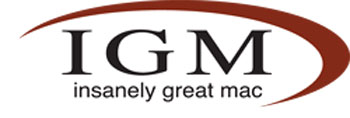Apple Hardware 2002: Steady as She Goes
December 24th 2002
Some big announcements, milestones and disappointments colored Apple's 2002. Highlights included cracking the 1GHz mark for the first time ever. And, of course, 2002 marked the company's 25th anniversary. One thing hasn't changed though: Steve Jobs is still at the company.
So how did Apple fare? Let's recap the year briefly.
Hardware: A lot of big hardware announcements. First up was the LCD iMac's January launch at MacWorld San Francisco. Despite photos leaking hours early, the design stuns the PC world and the order book is saturated. Come March, however, sales would backslide, leaving Cupertino with several weeks' worth of inventory.
The design wasn't iMac's only innovation. For the first time, we also saw the G4 in a consumer Mac, along with the SuperDrive, introduced on the Power Mac a year earlier.
Making less of an impact, but still important was Apple's addition of the 14.1" iBook to the consumer portable lineup. Loaded with premium equipment and premium pricing ($1,799), the iBook 14.1 bridged the gap between the 12.1" iBook and the 15.2" TiBook, providing a clear upgrade path for PowerBook G3 owners.
Hardly pausing for breath, Apple unveiled the "http://insanelygreatmac.com/news.php?id=331">eMac, its second consumer G4, but retaining the old iMac's CRT, but this time it measured 17". Initially restricted to education only, Apple quickly made the eMac available to all and even released a DVD-R-equpped version. The base eMac also dropped its price to $949 late in the year.
The Power Mac got its obligatory speed bump in January, this time - belatedly - breaking the 1GHz mark. Bigger updates came later in the year, with the 'Mirrored Drive Doors' enclosure released. Now dual processors, running at 867MHz, 1.0GHz and 1.25GHz, were standard across the model range, along with the ability to option in a second optical drive.
A few years ago, PowerBook accounted for only 15% of Mac sales. The iBook changed all that, although conservatism marked Apple's approach to its two portable lines during 2002, until year's end.
Apart from the 14.1" model introduced early in the year, the iBook continued remarkably unaltered from its May 2001 release. No rumored G4 or SuperDrive materialized. But prices fell late in 2002, giving Apple's its first $999 portable entry since the discounted PowerBook 100 in the early 1990s. However, iBook did get a significant graphics bump with the ATI Radeon 7500 shipping with 16 or 32MB of VRAM. It remains a mainstay in Apple's lineup and it's doubtful 2002 would have been a happy year without its vital contribution to total revenues.
Like the iBook, the PowerBook only saw incremental upgrades. DVI PowerBook G4s were introduced simultaneously with the eMac, now sporting 667 and 800MHz CPUs. The L3 cache was the big news, standard on both models, but the Radeon 7500 with 32MB RAM was a considerable improvement over the 16MB Mobility Radeon in the previous 667/550 TiBooks. Another important addition was the introduction of a new high-res LCD, now running at1280x854.
Then, in early November, Apple droppeda dual bombshell with a 1GHz high-end model (the first Mac portable to achieve these speeds) and a slot-loading DVD-R/RW. Graphics were bumped once again, this time to a Radeon 9000. Given the slow sales of the DVI PowerBooks, Apple drastically reduced prices on these 'Books, bringing in the SuoerDrive 1Ghz for a remarkable $2,999. The base 867MHz can be had for a mere $2,299.
Not forgetting XServe of course. The 1U rack-mount G4 supports more storage than any other server in its class, and comes at a price designed to lure prospective buyers away from Dells and IBMs. With its unlimited client license, XServe pays for itself, and it doesn't give anything away to PIII-based blade servers. And, with its solid Unix underpinnings, XServe is an admin's delight. Evidence that Apple got it right was an almost 300% increase in Apple's server sales. XServe 2 should be really something.
Finally, iPod contionued its run of success, with hard drive upgrades to 10 and 20GB. The original 5GB model continued at a lower price. New iPods, however, got redesigned scroll wheels and were slightly thinner and lighter than the original. Also released was a Windows version, with MusicMatch software instead of iTunes: it sold up a storm. Within months, iPod Wndows edition accounted for over 40% of sales.
All in all, 2002 represented a year of deep price cuts and outstanding value for any buyer of Mac hardware. At no other time in Apple's history has the company offered so much for so little money. Gone are the days of the $10.000 IIfx. Or the $6,500 PowerBook. The bonus is that they all ship with an outstanfing OS.
And we can't wait to see what they have in store for 2003. Maybe you'll get lucky with an AppleStore gift voucher under your tree this year.
